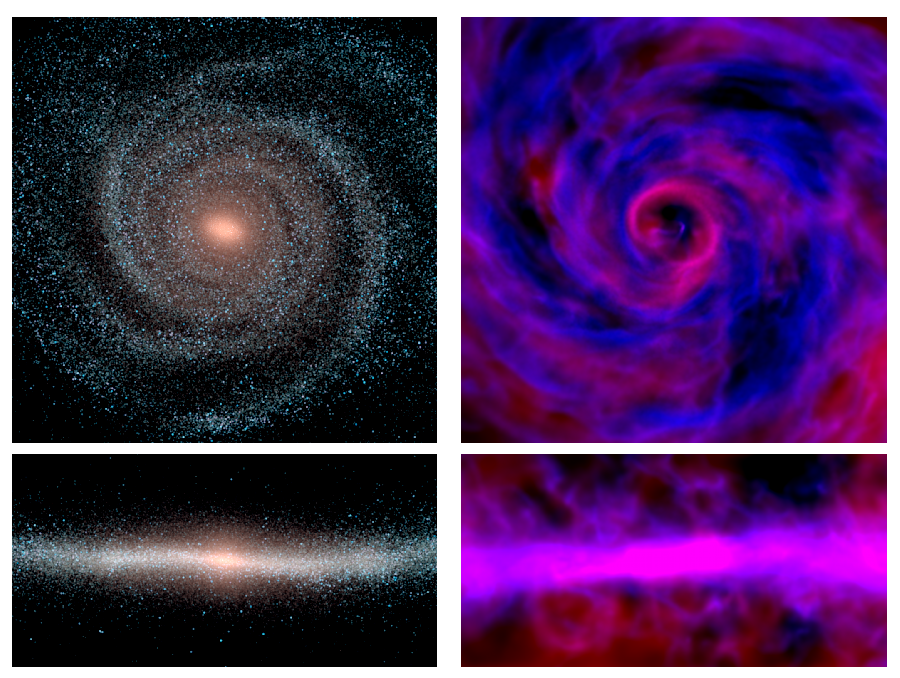A Milky Way out of the Supercomputer

The formation of disk galaxies has long been a conundrum for cosmologists: computer simulations produced typically far too massive and too small disks. Scientists at the Heidelberg Institute for Theoretical Studies (HITS) have now succeeded in including additional physical processes such as magnetic fields in the simulations, thereby improving them in a decisive way. With the help of novel numerical methods and a powerful supercomputer, they formed a virtual galaxy that closely resembles our own Milky Way. For the first time, they were able to predict the expected structure of the magnetic field in a galaxy directly from the initial conditions left behind after the Big Bang. The results of this study have been published in the „Astrophysical Journal Letters“.
Our Universe is permeated with magnetic fields – they are found on the Earth, in and around the Sun, as well as in our home galaxy, the Milky Way. Often the magnetic fields are quite weak: for example, the magnetic field on Earth is not strong enough to decisively influence the weather on our planet. In galaxies like the Milky Way, the field is however so strong that its pressure on the interstellar gas in the galactic disc is of about the same size as the gas thermal pressure. Astrophysicists hence conclude that magnetic fields could play an important role here although their origin still remains mysterious. Current hypotheses argue that they either already existed directly after the Big Bang and were then greatly amplified with time, or that the field was produced by the first stars and has then been dispersed in the Galaxy.
In principle, computer simulations that follow the formation and evolution of galaxies starting at the Big Bang ought to be able to answer these questions. However, they have thus far mostly failed because the predicted galaxies did not agree with astronomical observations. Also, the simulations have not been able to follow the dynamics of magnetic fields. Treating the latter is mathematically and numerically considerably more challenging than plain gas dynamics, which has typically been employed for computing galaxies.
With the help of the massively parallel simulation code AREPO, the authors of the new study at HITS managed to solve both problems for the first time. AREPO is a so-called “moving mesh code“ that has been developed at HITS. What distinguishes it from other astrophysical codes is that AREPO does not partition the simulated universe with a fixed mesh but rather uses a movable and deformable mesh, which allows a particularly accurate processing of the vastly different size and mass scales occurring in individual galaxies. In a detailed simulation of the formation of a disk galaxy similar to the Milky Way, the researchers could now include the amplification of magnetic fields. The calculations required the combined power of a large number of processors at the supercomputer SuperMUC at the Leibniz Rechenzentrum in Garching, within a project of the German Gauss Centre for Supercomputing.
“Already an extremely tiny magnetic field left behind by the Big Bang is sufficient to explain the orders of magnitude larger field strengths observed today“, summarizes Dr. Rüdiger Pakmor, first author of the study. The HITS astrophysicists were also able to show that the magnetic field first grows exponentially for about 1 billion years due to gas motions in the early Universe, before the field reaches a stationary average value that is independent of its initial strength. Once the first disk galaxies have formed (ca. 2.5 billion years after the Big Bang), the rotational motion of the disk further amplifies the field linearly with time. The revolving flow of the gas in the disk also pulls the magnetic field lines and directs them tangentially along this motion, similar to iron filings that orient themselves towards a magnet. “Interestingly, the magnetic field strength found in the simulation does not only agree very well with the values measured for the Milky Way and neighboring galaxies“, comments coauthor Dr. Federico Marinacci, “but also its vertical and horizontal profiles are consistent with the observations.“
Prof. Volker Springel, head of the research group “Theoretical Astrophysics“ at HITS and author of the AREPO code explains: “Finally we have achieved a breakthrough in the intricate problem of the formation of disk galaxies. It is fascinating that we can at the same time explain the formation of the Milky Way and the evolution of its magnetic field.“ These findings also promise to help in understanding the deflection of cosmic ray particles in the magnetic field of the Milky Way, and in providing clues for tracking down the sources of these particles, which is still an unsolved problem in observational astronomy.
Original scientific publication:
Magnetic field in cosmological simulations of disk galaxies. R. Pakmor, F. Marinacci, V. Springel, 2014, Astrophysical Journal Letters, 783, L20, http://stacks.iop.org/2041-8205/783/L20 (preprint: http://arxiv.org/abs/1312.2620)
Further links:
Gauss Centre for Supercomputing http://www.gauss-centre.eu/
SuperMUC am Leibniz Rechenzentrum http://www.lrz.de/services/compute/supermuc/
AREPO-Code (V. Springel, 2010, MNRAS, 401, 791 http://mnras.oxfordjournals.org/content/401/2/791.full.pdf+html)
Press contact:
Dr. Peter Saueressig
Head of Communications
Heidelberg Institute for Theoretical Studies (HITS)
Phone: +49-6221-533245
Peter.saueressig@h-its.org
www.h-its.org
Twitter: @HITStudies
About HITS
HITS, the Heidelberg Institute for Theoretical Studies, was established in 2010 by physicist and SAP co-founder Klaus Tschira (1940-2015) and the Klaus Tschira Foundation as a private, non-profit research institute. HITS conducts basic research in the natural, mathematical, and computer sciences. Major research directions include complex simulations across scales, making sense of data, and enabling science via computational research. Application areas range from molecular biology to astrophysics. An essential characteristic of the Institute is interdisciplinarity, implemented in numerous cross-group and cross-disciplinary projects. The base funding of HITS is provided by the Klaus Tschira Foundation.